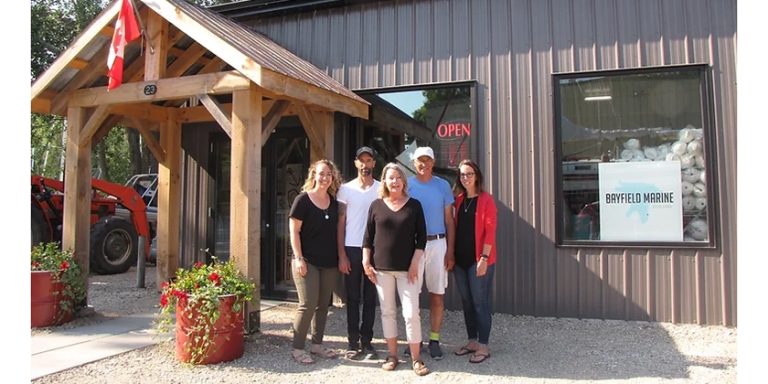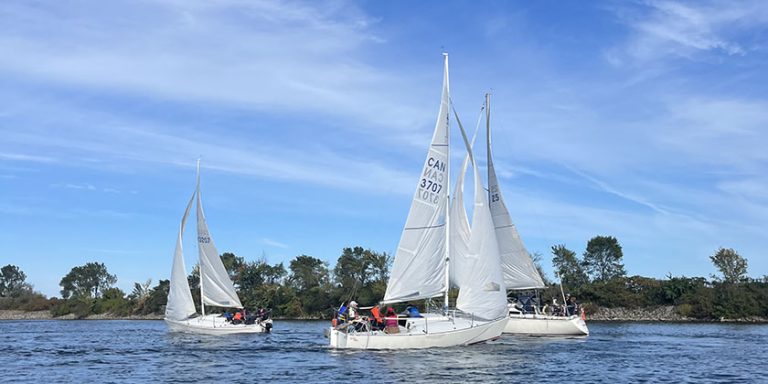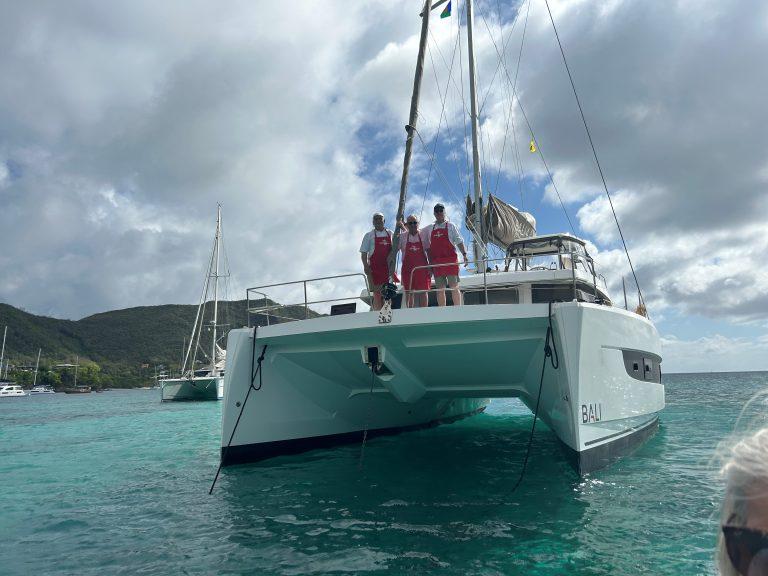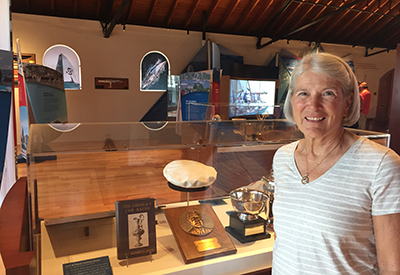Kingston Yacht Club
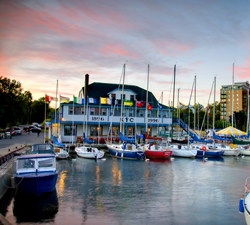
By Katherine Ston e
e
A Sense of History and a Bright Future
Club historians are always the heart of a yacht club’s soul and are to be revered and saluted for their tireless work of keeping the club’s archives intact and accurate. David Page is just one of those people, and he sure made my job pretty easy when it came to the beginnings of Kingston Yacht Club.
Kingston, as described by the local newspaper in the day was, “The city situated on a magnificent sheet of water, not second to any in America for yachting purposes. It is no wonder then, that yachting and boating have been a part of harbor scene for some 200 years.” But there’s much more to this town than meets the eye.
Located where three waterways come together; Lake Ontario, the Rideau Canal, and the St. Lawrence River, Kingston is the site of one of the earliest European settlements in Ontario. As an important location for Canada’s First Nations, the French desired control of the trade which led to the founding of a French trading post known as Fort Frontenac in 1673. The town of Cataraqui was renamed “King’s Town” in honour of King George III and shortened to Kingston in 1788. It soon became a popular hang-out for Loyalist refugees fleeing the American Revolutionary War.
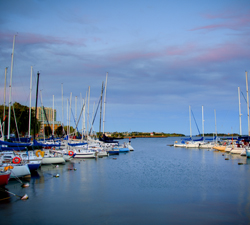 Bring on the War of 1812, often referred to as the “War of Defiance”, and Kingston became the base for the Great Lakes British naval fleet. To support the fleet, the Rideau Canal was completed in 1832, now incorporating Kingston as a town and the primary military and the economic centre of Upper Canada. Shortly thereafter, Fort Henry and its series of distinctive Martello towers, was constructed to guard the entrance to the Rideau. The summer twilight guard ceremony is a “must see” on your cruising to-do list! Having all this in their favour, Kingston was then named the first capital of the Province of Canada on February 15, 1841 by Governor Lord Sydenham.
Bring on the War of 1812, often referred to as the “War of Defiance”, and Kingston became the base for the Great Lakes British naval fleet. To support the fleet, the Rideau Canal was completed in 1832, now incorporating Kingston as a town and the primary military and the economic centre of Upper Canada. Shortly thereafter, Fort Henry and its series of distinctive Martello towers, was constructed to guard the entrance to the Rideau. The summer twilight guard ceremony is a “must see” on your cruising to-do list! Having all this in their favour, Kingston was then named the first capital of the Province of Canada on February 15, 1841 by Governor Lord Sydenham.
Queen’s University was founded at that same time, and was followed 35 years later by the Royal Military College of Canada. Canada’s first Prime Minister, Sir John A. Macdonald, established a residence there in the 1840s named Bellevue House where he was told that his ailing wife would be able to rest and recuperate. Not to their credit, Kingston also has the largest concentration of federal correctional facilities, hummmmm??? Now, onto the boating part…
The formation of a yacht club did not deter sailors from puttering about. However, in 1895 the Kingston Ice Yacht Club was formed to captivate the hardy, cold, weather sailors. This was the pinball that got some 175 “pleasant weather” sailors going to form their own club in 1896. Waterfront land was acquired at “Cameron’s Wharf” and a 40×40 two-story structure was built that opened on August 3rd of that year. Racing commenced almost immediately with canoes, batwing skiffs and swimming! The following year, KYC joined LYRA (Lake Yacht Racing Association) and hosted the first race of the circuit. Believe it or not, it turned into a drifting match as there was no wind…. Yes, you heard me…. No wind in Kingston! So the club hosted the LYRA Rendezvous Regatta to make up for the previous year. The Wind Gods approved and granted them the typical “SW, medium to strong, 11-17 hours, for days on end, wind.”
 Racing was thriving and David recounts that, “By 1902 KYC was sending two of its fleet to compete at the Pan-American Exposition in Buffalo…. Keep in mind back then that there was virtually no road transport available leaving sailing, shipping and trains as the only means available to reach other venues. No wonder that the big racing yachts were 30 footers or more, tackling Lake Ontario with compass and charts, no engines and lots of weather.”
Racing was thriving and David recounts that, “By 1902 KYC was sending two of its fleet to compete at the Pan-American Exposition in Buffalo…. Keep in mind back then that there was virtually no road transport available leaving sailing, shipping and trains as the only means available to reach other venues. No wonder that the big racing yachts were 30 footers or more, tackling Lake Ontario with compass and charts, no engines and lots of weather.”
To accommodate the expanding membership in 1906, the club acquired the “Saints Rest” stone building and negotiated the use of Cedar Island for parties and picnics. Sounding like a script from an old movie, as of course things were going too well, the clubhouse burned to the ground in 1934. But, just like when it began, the clubhouse was rebuilt the following year with the help from a solid base of 400 members.
Mr. Page also related a story which I remember well in my youth with a gathering of men discussing the preposterous idea of women becoming members! “From the outset, lady and junior ‘members’ were active in KYC operations, although real membership did not arrive for the ladies until many verbal battles had been fought, all seeming so pointless now. One of these arose in the early 1920s, when a Toronto skipper objected to the boat belonging to the Principal of Queen’s University being crewed by the Principal’s four daughters in an upcoming regatta. It was actually reported in the Toronto Star as ‘the female menace has hit yachting’! Needless to say, you can imagine who came in first…”
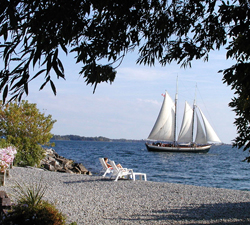 The club’s purpose “to encourage the building and sailing of yachts, canoes and motorboats, rowing, canoeing and all other aquatic sports” still rings true. Although no real junior sailing program was introduced until 1951, it carries on today with Wet Fee, Opti, and levels 1-4 CANSAIL programs. The kids all look forward to the special event days at White Mountain Ice Cream and sailing to Cedar Island for a B-B-Q and traditional game of capture the flag! KYC also hosts Able Sail Kingston which began in 2002 and allows participants to sail in specially designed untippable Martin 16s.
The club’s purpose “to encourage the building and sailing of yachts, canoes and motorboats, rowing, canoeing and all other aquatic sports” still rings true. Although no real junior sailing program was introduced until 1951, it carries on today with Wet Fee, Opti, and levels 1-4 CANSAIL programs. The kids all look forward to the special event days at White Mountain Ice Cream and sailing to Cedar Island for a B-B-Q and traditional game of capture the flag! KYC also hosts Able Sail Kingston which began in 2002 and allows participants to sail in specially designed untippable Martin 16s.
The regular racing scene is very active with bi-weekly evening races, regular fleet-sponsored TGIFs, and radio controlled racing on Monday nights from May to October. As Archivist Page reminds me, “No history of KYC would be complete without mention of CORK and the 1976 Olympics. The famous story recounts how a CYA member was driving an Aussie sailor back to Toronto from a world championship regatta in Montréal. The regatta had been a flop because of no wind. The CYA member suggested a stopover at KYC to show the Aussie some real wind. This was August 1967 and the wind was blowing 18 knots. The CYA member later urged the CYA Olympic Committee to choose Kingston as Canada’s answer to Kiel Week and other salt-water sites for Olympic training.
Out of this the CYA Olympic Committee became CORK led by the “Apostles of CORK”, its twelve strong-willed personalities from Kingston, most of whom were KYC members. CORK started its first year in 1969, with 271 boats and 495 competitors. In 1976 Kingston was formally chosen the Olympic sailing site. KYC members played a major role in planning and implementation for the 1972 Olympic games.”
KYC also secured 4 mooring balls, and a new, floating dock (10’ x 108’) which can accommodate 8-10 boats, fire pit, cooking facilities, chairs, and outhouses at Jemmet’s Landing. Located just west of Brakey Bay at the east end of Wolfe Island, it is an easy sail from the KYC Harbour for an overnight or on the way to cruise the Thousand Islands. Commodore Chris Walmsley mentioned that they even have a race in mid-July called the Partridge Bowel where there are reverse starts so that everyone ends up at Jemmett’s Landing at the same time to consume Gin and Tonics from the trophy! It’s a very sought after place. The club’s extensive cruising program also includes a series of Saturday day sails and weekend cruises with most rendezvous destinations accessible by road as well as water.
 Knowing that the infrastructure of the club is aging and the harbor is cramped, the board launched a new strategic plan in 2013. Chris continues, “We are in the process of trying to secure funding, and keep the project moving along. Part of the work will be to rebuild some of the aging infrastructure at the club, such as parts of our existing break wall, and part of the center dock (upon which the club sits). Upgrading our harbor from primarily Mediterranean-style moorings to proper finger docks, with water and electrical will provide a significant improvement in value for members and visitors. The project will be quite extensive, but will keep the club on track for a strong future for another 100 years by improving what we can offer, and allowing us to grow our membership.”
Knowing that the infrastructure of the club is aging and the harbor is cramped, the board launched a new strategic plan in 2013. Chris continues, “We are in the process of trying to secure funding, and keep the project moving along. Part of the work will be to rebuild some of the aging infrastructure at the club, such as parts of our existing break wall, and part of the center dock (upon which the club sits). Upgrading our harbor from primarily Mediterranean-style moorings to proper finger docks, with water and electrical will provide a significant improvement in value for members and visitors. The project will be quite extensive, but will keep the club on track for a strong future for another 100 years by improving what we can offer, and allowing us to grow our membership.”
Come join this invigorating, adaptive, and supportive club that sets KYC apart among other friendly rival clubs on Lake Ontario.
KYC; 1 Maitland Street; Kingston, Ontario K7L 2V3 613-548-3052 www.kingstonyachtclub.com
Photos:
Photo 1: A beautiful summer sunset and a wonderful weekend ahead!
Photo 2: Looking out from the yacht club toward Fort Henry
Photo 3: Shark North Americans 2010
Photo 4: The club’s small beach allows for a relaxing afternoon with a good book
Photo 5: Moorings right in front of the KYC Clubhouse



